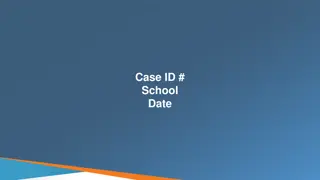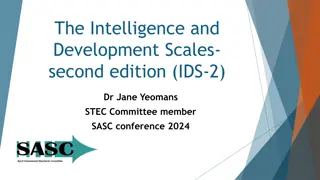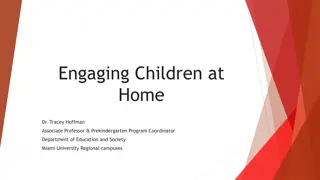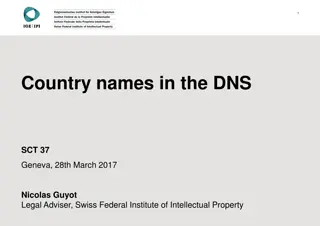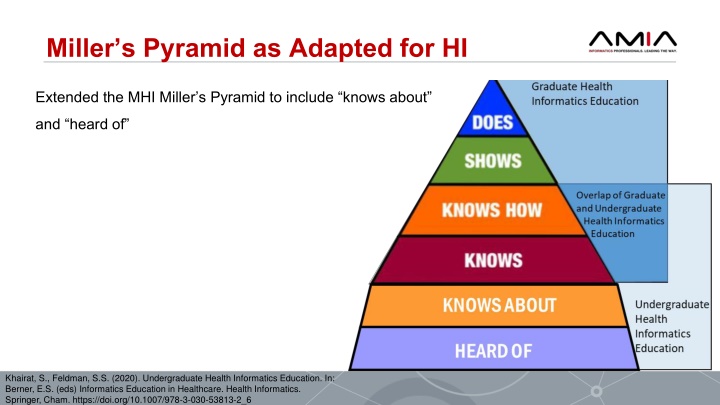
Foundational Domains in Health Informatics Education
Explore the foundational domains in health informatics education, covering key topics such as health science fields, information science and technology, social and behavioral science, and health information science and technology. Gain insights into essential skills and knowledge required for success in the field.
Download Presentation

Please find below an Image/Link to download the presentation.
The content on the website is provided AS IS for your information and personal use only. It may not be sold, licensed, or shared on other websites without obtaining consent from the author. If you encounter any issues during the download, it is possible that the publisher has removed the file from their server.
You are allowed to download the files provided on this website for personal or commercial use, subject to the condition that they are used lawfully. All files are the property of their respective owners.
The content on the website is provided AS IS for your information and personal use only. It may not be sold, licensed, or shared on other websites without obtaining consent from the author.
E N D
Presentation Transcript
Millers Pyramid as Adapted for HI Extended the MHI Miller s Pyramid to include knows about and heard of Khairat, S., Feldman, S.S. (2020). Undergraduate Health Informatics Education. In: Berner, E.S. (eds) Informatics Education in Healthcare. Health Informatics. Springer, Cham. https://doi.org/10.1007/978-3-030-53813-2_6
Foundational Domains Adapted from Masters Domains 10 domains 3 major domains Valenta, A. L., Berner, E. S., Boren, S. A., Deckard, G. J., Eldredge, C., Fridsma, D. B., Gadd, C., Gong, Y., Johnson, T., Jones, J., Manos, E. L., Phillips, K. T., Roderer, N. K., Rosendale, D., Turner, A. M., Tusch, G., Williamson, J. J., & Johnson, S. B. (2018). AMIA Board White Paper: AMIA 2017 core competencies for applied health informatics education at the master's degree level. Journal of the American Medical Informatics Association : JAMIA, 25(12), 1657 1668. https://doi.org/10.1093/jamia/ocy132
Major domains Knowledge-based Health Identify, describe, etc. Information Science & Technology Social and Behavioral Science Crossovers create F4-7
Domains F4-10 and KSAs Skills F1 Attitudes F6 F4 F7 F3 F2 F5
Domains F4-10 and KSAs Knowledge (F1-10) Skills (F4-10) Attitudes (F4-10)
Foundational Domains F1 Health At the time of graduation from an applied bachelor s program related to health informatics, the undergraduate student should be able to Describe the history, goals, methods (including data and information used and produced), and current challenges of the major health science fields. These include foundations in healthcare terminology, clinical workflow and processes, healthcare delivery and the healthcare environment, translational science, patient engagement, consumer health, public health, and quality improvement. F2 Information Science and Technology At the time of graduation from an applied bachelor s program related to health informatics, the undergraduate student should be able to Understand key concepts and methods used in information science and technology. Identify the applicable tools for data capture, storage, retrieval, and analysis for a given informatics problem. Work in teams to secure/protect information. 6
Foundational Domains F3 Social and Behavioral Science At the time of graduation from an applied bachelor s program related to health informatics, the undergraduate student should be able to K- Identify the effects of social, behavioral, and psychological models applicable to health informatics from multiple levels including individuals, organizations, social groups, and society. F4 Health Information Science and Technology At the time of graduation from an applied bachelor s program related to health informatics, the undergraduate student should be able to K - Identify possible biomedical and health information science and technology methods and tools for solving a specific biomedical and health information problem. Core health information technology tools may be dependent upon the application area of the training program. S- Identify and describe a solution to a biomedical or health information problem by applying computational and systems thinking, information science, and technology. A - Demonstrate consideration of the advantages and limitations of using information science and technology to solve biomedical and health information problems as well as the needs of the different stakeholders and context. 7
Foundational Domains F5 Human Factors and Socio-technical Systems At the time of graduation from an applied bachelor s program related to health informatics, the undergraduate student should be able to Draw on socio-technical knowledge regarding the social behavioral models and human factors engineering to identify the design and implementation principles of information systems and technology. Identify and describe social behavioral models and human factors engineering relevant to the design and evaluation of information systems and technology. Demonstrate sensitivity to (understanding of) for the role of users in the design and application of information systems and technology. F6 Social and Behavioral Science Aspects of Health At the time of graduation from an applied bachelor s program related to health informatics, the undergraduate student should be able to Understand models that explain and modify patient or population behaviors related to health and health outcome. Identify models, which may be dependent upon the application area of the training program, to address social and behavioral problems related to health of individuals, populations, and organizations Recognize the importance of social and behavioral models related to health and their contribution to the health of individuals and populations. 8
Foundational Domains F7 - Social, Behavioral, and Information Science and Technology Applied to Health At the time of graduation from an applied bachelor s program related to health informatics, the undergraduate student should be able to Identify the models from social, organizational, human factors, behavioral, and information sciences and technologies for designing, implementing, and evaluating health informatics solutions. Models may be dependent upon the application area of the educational program. Identify and describe the models from social, organizational, human factors, behavioral, and information sciences and technologies to design, implement, and evaluate health informatics solutions. Models may be dependent upon the application area of the educational program Recognizes the interrelatedness of social, organizational, human factors, behavioral, and information sciences and technologies in the design, implementation, and evaluation of health informatics solutions. F8 - Professionalism At the time of graduation from an applied bachelor s program related to health informatics, the undergraduate student should be able to Define and discuss ethical principles and the informaticians' roles and responsibilities to the profession, their employers, patients, health consumers, and any other stakeholders of the informatics solutions they aid in developing, implementing, and maintaining. Define professional practices that incorporate ethical principles and values of the discipline and demonstrate professionalism during interactions with colleagues and stakeholders in the field. Demonstrate awareness of the value of information literacy and lifelong learning, maintenance of skills, and professional excellence. 9
Foundational Domains F9 Interpersonal Collaborative Practice At the time of graduation from an applied bachelor s program related to health informatics, the undergraduate student should be able to Define the scope of practice and roles-and responsibilities of different health professionals and stakeholders to perform effectively in different team roles to solve health information problems. Apply the principles of interprofessional communication practices in a responsive and responsible manner as a participant that supports a team-based approach to solving health information problems. Recognizethe importance of mutual respect and shared values, one s own role and those of other professions and stakeholders, and the role of teams and teamwork to solve health information problems. F10 - Leadership At the time of graduation from an applied bachelor s program related to health informatics, the undergraduate student should be able to Articulate the concepts, tools, and characteristics of various leadership models. Describe skills about leadership and followership concepts and tools to ensure a team progresses toward accomplishing a health informatics vision. Demonstrate leadership behaviors as a participant in the larger goal of achieving a vision for health informatics solutions. 10
Questions? Christina Eldredge celdredge2@usf.edu



